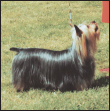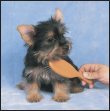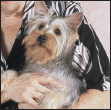Physical Characteristics of the Silky Terrier
(from the American Kennel Clubs breed standard)
Head: Strong, wedge-shaped, and moderately long.
Eyes: Small, dark, almond shaped with dark rims.
Nose: Black.

Teeth: Strong and well aligned, scissors bite.
Ears: Small, V-shaped, set high and carried erect.
Skull: Flat, and not too wide between the ears. The skull is slightly longer than the muzzle.
Neck: Fits gracefully into sloping shoulders. It is medium long, fine, and to some degree crested.
Chest: Medium wide and deep enough to extend down to the elbows.
Forequarters: Well laid back shoulders, together with proper angulation at the upper arm, set the forelegs nicely under the body. Forelegs are strong, straight and rather fine-boned.
Coat: Straight, single, glossy, silky in texture. On matured specimens the coat falls below and follows the body outline. On the top of the head, the hair is so profuse as to form a topknot. The tail is well coated but devoid of plume. Legs should have short hair from the pastern and hock joints to the feet.
Body: Moderately low set and about one-fifth longer than the dogs height at the withers.
Tail: Docked, set high and carried at twelve to two oclock position.
Hindquarters: Thighs well muscled and strong, but not so developed as to appear heavy. Well angulated stifles with low hocks which are parallel when viewed from behind.
Color: Blue and tan.
Feet: Small, catlike, round, compact. Pads are thick and springy while nails are strong and dark colored. The feet point straight ahead.
Size: Shoulder height from 9 to 10 inches.

Contents

Trace the Silky Terrier back to its early ancestors, plus meet the breeds two closest relatives: the Australian Terrier and the Yorkshire Terrier. Follow the Silkys development in Australia and travel with the Silky to other lands, notably the US, where the breed has earned one of the most dedicated followings outside its homeland.

The result of toy and terrier breeding, the charming Silky Terrier embodies the best of both worlds. Are you ready for a ball of terrier fire in a pint-sized blue and tan package? Feisty yet devoted, spirited yet refined, the Silky is a hardy little companion whos sure to delight. Find out about the breed to see if you and the Silky are a perfect match!

Learn the requirements of a well-bred Silky Terrier by studying the description of the breed as set forth by the American Kennel Club. Both show dogs and pets must possess key characteristics as outlined in the standard.

Be advised about choosing a reputable breeder and selecting a healthy, typical puppy. Understand the responsibilities of ownership, including home preparation, acclimatization, the vet and prevention of common puppy problems.

Enter into a sensible discussion of dietary and feeding considerations, exercise, grooming, traveling and identification of your dog. This chapter discusses Silky Terrier care for all stages of development.

By Charlotte Schwartz
Be informed about the importance of training your Silky Terrier from the basics of house-breaking and understanding the development of a young dog to executing obedience commands (sit, stay, down, etc.).

Discover how to select a qualified vet and care for your dog at all stages of life. Topics include vaccinations, skin problems, dealing with external and internal parasites and common medical and behavioral conditions.

Consider the care of your senior Silky Terrier, including the proper diet for a senior. Recognize the signs of an aging dog, both behavioral and medical; implement a special-care program with your vet and become comfortable with making the final decisions and arrangements for your senior Silky Terrier.

Learn to recognize and handle behavioral problems that may arise with your Silky Terrier. Topics discussed include separation anxiety, aggression, barking, chewing, digging, begging, jumping up and more.

K ENNEL C LUB B OOKS S ILKY T ERRIER
ISBN 13: 978-1-59378-358-7
eISBN 13: 978-1-59378-991-6
Copyright 2003 Kennel Club Books An Imprint of I-5 Press A Division of I-5 Publishing, LLC
3 Burroughs, Irvine, CA 92618 USA
Cover Design Patented: US 6,435,559 B2 Printed in South Korea
All rights reserved. No part of this book may be reproduced in any form, by photostat, scanner, microfilm, xerography or any other means, or incorporated into any information retrieval system, electronic or mechanical, without the written permission of the copyright owner.
Photos by Isabelle Francais and Michael Trafford, with additional photographs by:
Norvia Behling, T. J. Calhoun, Doskocil,
Carol Ann Johnson, Bill Jonas, Mikki Pet Products, Alice van Kempen and R. Willbie.
The publisher would like to thank all of the owners of the dogs featured in this book, including Tarianne Gallegos, Mrs. Marshall, Angelica C. Mazzarella, Rosemarie Napoleone, Jean Wagner and Doreen Weintraub.
Illustrations by Patricia Peters.

By any other name, the Silky Terrier is one of the worlds most delightful little breeds, renowned for its soft, silky coat and its appealing temperament.

The name game! Before we meet the Silky Terrier, lets take a moment to marvel at all of the names once assigned this breed. Today called the Silky Terrier in the United States and Canada, and the Australian Silky Terrier in Australia and the United Kingdom, the breed has also been called the following names: Australian Terrier, Soft or Silky Coated; Terrier, Soft and Silky; Sydney Silky Terrier; Victorian Silky Terrier; Soft as Silk; Broken-coated Toy Terrier and Broken-coated Blue Terrier. To further confound his fans, in Australia, the UK, the US and Canada, the Silky Terrier competes in the Toy Group, while in Europe and beyond, we find him in the Terrier Group. With over 100 years spent hammering out these details, it is no wonder that such a delightful little dog was, for decades, a novelty to lovers of terrier types.




























